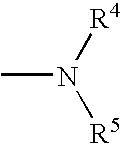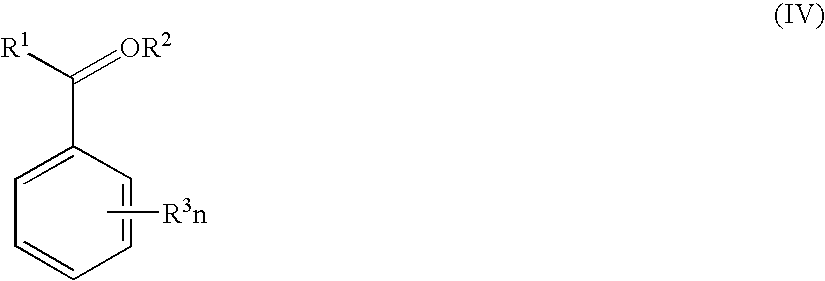Propylene block copolymer
a technology of propylene polymer and polymer, applied in the direction of adhesives, coatings, etc., can solve the problems of surface fouling, difficult bonding to polar substances or blend with polar resins, and techniques that require special apparatuses, etc., to achieve excellent affinity, high solubility, and satisfactory adhesiveness to propylene polymers
- Summary
- Abstract
- Description
- Claims
- Application Information
AI Technical Summary
Benefits of technology
Problems solved by technology
Method used
Image
Examples
example 1
Production of OH-Terminated Propylene Polymer
[0280] (i) Synthesis of Dichloro[dimethylsilylene-(cyclopentadienyl)(2,4-dimethyl-4H-1-azulenyl)zirconium
[0281] (i)-1: Ligand Synthesis
[0282] 2-Methylazulene (12.10 g; 0.085 mol) was dissolved in tetrahydrofuran (168 mL) and this solution was cooled to 5° C. with an ice bath. Thereafter, a diethyl ether solution of methyllithium (1.04 mol / L; 83 mL; 0.086 mol) was added dropwise to that solution at that temperature. After completion of the dropwise addition, the ice bath was removed and the mixture was stirred for 3 hours. The resultant solution was gradually added dropwise to a tetrahydrofuran solution (420 mL) of dimethylsilyl dichloride (22.5 mL; 0.185 mol) which had been cooled to 5° C. with an ice bath. After completion of the dropwise addition, the ice bath was removed and the mixture was stirred for 3 hours. Thereafter, the solvent and the dimethylsilyl dichloride remaining unreacted were distilled off under reduced pressure. Tet...
example 2
Synthesis of Amino-Terminated Polypropylene
[0297] First, 4-{2-[N,N-bis(trimethylsilyl)amino]ethyl}styrene (hereinafter referred to as VSA) was synthesized by the method described in J. Y. Dong et al., Macromol., 35, 9352 (2002).
[0298] Subsequently a chemically treated montmorillonite obtained in the same manner as in Example 1 (ii) was vacuum-dried at 200° C. for 2 hours to obtain the dried montmorillonite in an amount of 1.0 g on a dry basis. Thereto was added a toluene solution of triethylaluminum (0.5=mol / mL; 7.0 mL). This mixture was stirred at room temperature for 30 minutes. Twenty milliliters of toluene was added to the resultant suspension and the supernatant was removed after stirring. This operation was repeated twice to obtain a clay slurry.
[0299] On the other hand, 12.4 mL of toluene was added to 16.0 mg (36.3 μmol) of the dichloro[dimethylsilylene-(cyclopentadienyl)(2,4-dimethyl-4H-1-azulenyl)]zirconium obtained in (i) in Example 1. Thus, a complex solution was prepa...
example 3
Propylene Block Copolymer (Propylene Polymer / Acrylic Acid Polymer)
[0304] (i) Synthesis of Br-Terminated Polypropylene
[0305] In 200 mL of methylene chloride was dissolved 20.7 g of the hydroxylated polypropylene obtained in Example 1. Separately from this, 2.0 mL of triethylamine was added to a solution of 0.83 g of DMAP (4-(dimethylamino)pyridine) in 100 mL of methylene chloride, and 1.2 mL of PBC (2-bromopropionyl chloride) was added thereto at 0° C. Thereto was added the solution of the hydroxylated polypropylene over 67 minutes. This mixture was heated to room temperature and stirred overnight. The solvent was distilled off in an amount of 200 mL, and 420 mL of toluene was added to the residue. The solid was taken out by filtration, and 1,000 mL of methanol was added to the filtrate to cause reprecipitation. This reaction product was purified by repeatedly conducting dissolution in toluene and reprecipitation from methanol. The precipitate was dried at 40° C. for 1 day to obtai...
PUM
| Property | Measurement | Unit |
|---|---|---|
| chemical shift | aaaaa | aaaaa |
| chemical shift | aaaaa | aaaaa |
| temperature | aaaaa | aaaaa |
Abstract
Description
Claims
Application Information
 Login to View More
Login to View More - R&D
- Intellectual Property
- Life Sciences
- Materials
- Tech Scout
- Unparalleled Data Quality
- Higher Quality Content
- 60% Fewer Hallucinations
Browse by: Latest US Patents, China's latest patents, Technical Efficacy Thesaurus, Application Domain, Technology Topic, Popular Technical Reports.
© 2025 PatSnap. All rights reserved.Legal|Privacy policy|Modern Slavery Act Transparency Statement|Sitemap|About US| Contact US: help@patsnap.com



